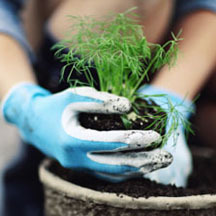Get ready for summer with these early spring lawn and garden projects!
When winter has dragged on, it can be hard to wait to plant your garden, but if you try digging in your garden too early, you may end up doing more damage than good. Luckily, we're here to help with a list of ideas to keep your green thumb busy until then. Below you will find eight early spring lawn and garden projects for you to try.
8 Early Spring Lawn and Garden Projects
1. Do a Soil Test
Have a soil test done on your dirt, or even do one yourself! You can pick up soil collection bags for your samples at your local extension office or purchase a soil test kit at your local Blain’s Farm & Fleet. Keep in mind you may want to do multiple tests for your lawn soil, and your garden soil as recommendations may vary whether you plan on growing flowers, vegetables, or grass.

2. Make a Compost Heap or Bin
If you haven’t already done so, now is a great time to get one started. Visit our How to Build a Compost Bin project for step-by-step instructions on how to turn your common household and garden waste into “black gold” for your plants.
3. Replace Your Mulch and Add Amendments
This is a good time to renew the mulch around all your plants before the new foliage fills out. Use the accumulated compost from the winter (yet another reason to build a compost bin if you don’t have one already) and spread it around all your plants–they’ll love you for it when the weather does finally warm up!
4. Prune Your Shrub Roses
When your roses start to bud, you can easily tell where there is deadwood that needs to be removed. When deciding where to prune your roses, look for a healthy bud that is pointing outward. Make your cut at a 45-degree angle about 1/4″ above the rosebud. If you see brown tissue in the center of the cane, go down a little further until you find healthy tissue.
5. Clean Out All Your Pots and Containers
Remove old potting soil from your planters and dump it into your compost bin. Do not reuse the same soil mix as any diseases that were present last year will carry over. Scrub each container with powdered laundry detergent and water, then disinfect the pot with bleach and water. Rinse well, and voila–your pots are disinfected and ready to plant when the weather permits.
6. Sharpen and Clean Your Garden Tools
Many gardeners expend twice the energy they need when their garden tools aren’t kept sharpened. An electric grinder or a flat-file are two great ways to get the job done. Start by putting the tool in a vise and make long, firm strokes in one direction. When you’ve sharpened the entire length of the blade, turn the tool over and rub off any burrs. For a more in-depth look, read through our sharpening methods guide.
7. Work on Your Seed Plan
Get out your nursery catalogs, and make sure to get your order in now for all those new perennials you had your eye on when the catalogs first started arriving last January. Planning and dreaming what your garden will look like ensures you will get the most out of the crucial time of spring planting. Don't forget that you can pick up plants, bulbs, and seeds at your local Blain’s Farm & Fleet.
8. Keep a Garden Journal
This can be one of the most satisfying things you can do with your time in the long winter months. Whether it is chores we need to remember when spring comes or where we put a new plant last fall… a garden journal is invaluable but a nifty asset to have.